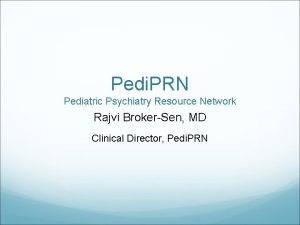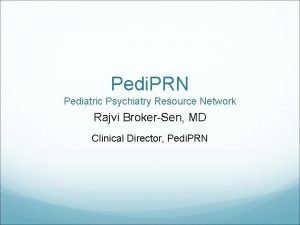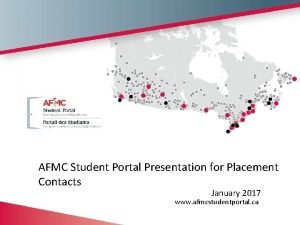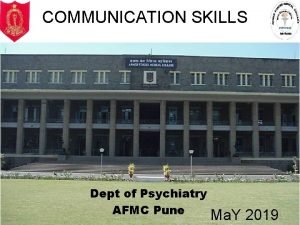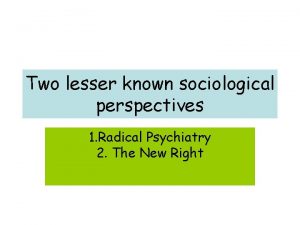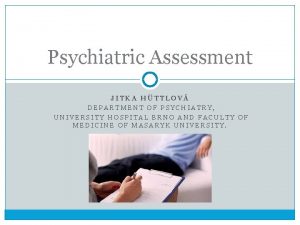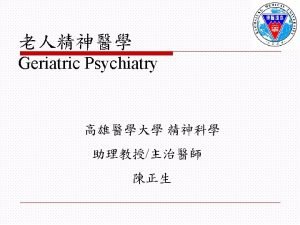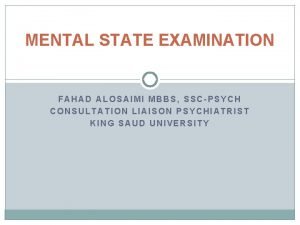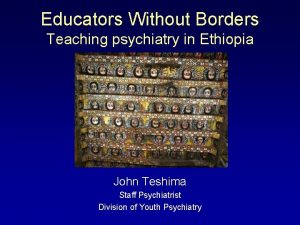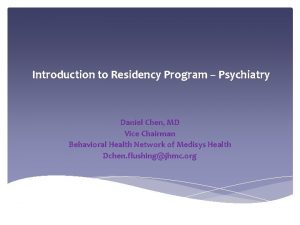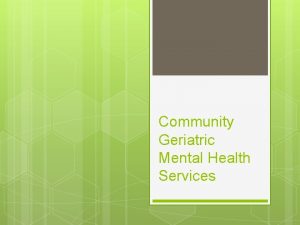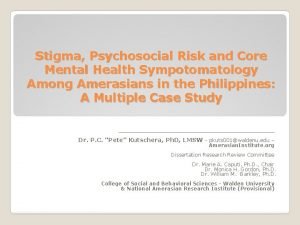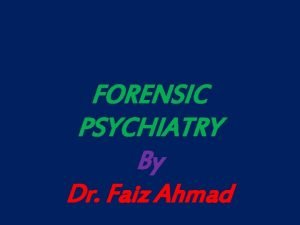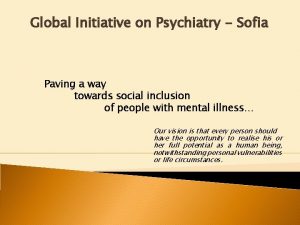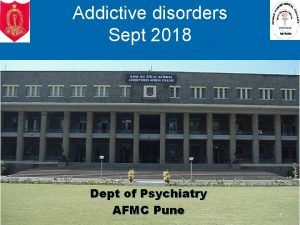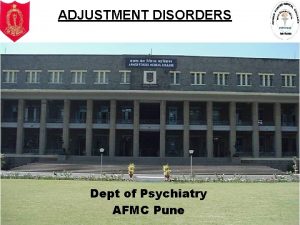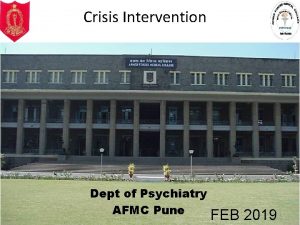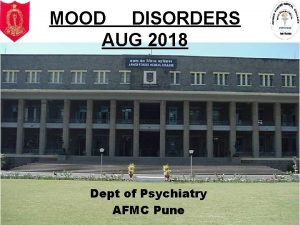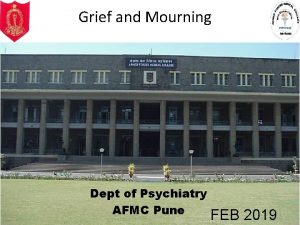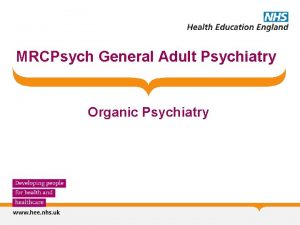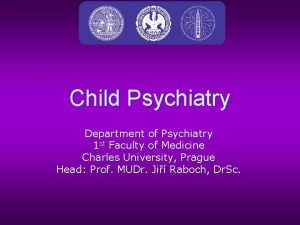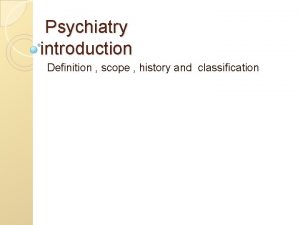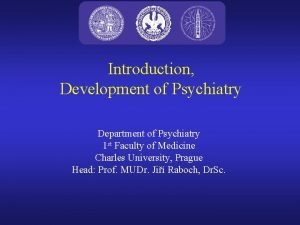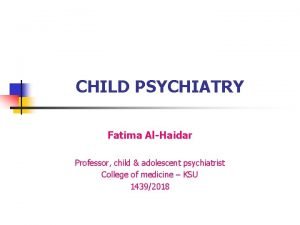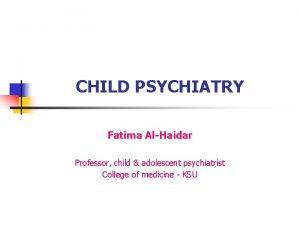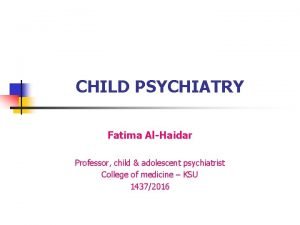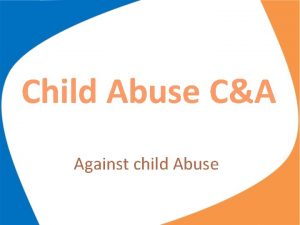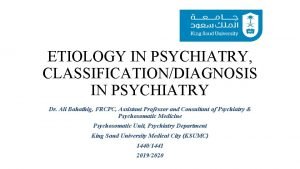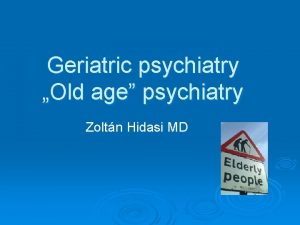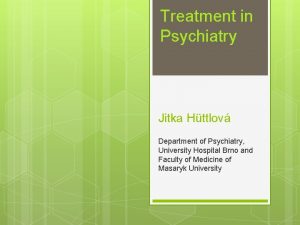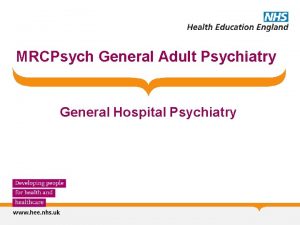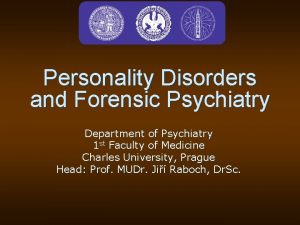Introduction to Child Psychiatry Dept of Psychiatry AFMC

























- Slides: 25

Introduction to Child Psychiatry Dept of Psychiatry AFMC Pune 1

SLO n n n Understanding few psychiatric conditions of childhood Why study child psychiatry separately Overview of workup in child psychiatry case

So how are you feeling ?

Definitions Psychiatric Disorder n n n Cluster of signs and symptoms Which when present together in an individual For a significant duration of time Lead to significant distress and dysfunction Social deviance alone is not psychiatric disorder

Why Study Psychiatry ? n Psychiatric disorders are prevalent and often go untreated : * lifetime prevalence in India : 28% * Only 10% receive treatment during lifetimes * in general practice : 30% of the patients seen in general medical care have a psychiatric problem

Famous dyslexics

Dyslexics write like this


Despite adequate info abuse is rampant

How common are these problems?

Which of these may be a problem? n A 3 -year-old soiling during the day A 7 -year-old soiling during the day n Frequent temper tantrums aged 2 Frequent temper tantrums aged 10 n Severe anxiety at leaving mother at nursery gate aged 3 Severe anxiety at leaving mother at secondary school gate aged 11

Definition of a “problem” n ABNORMAL in relation to n child’s age, gender, developmental stage, persistence n extent of disturbance n severity and frequency n IMPAIRMENT n causes suffering to child/distress to family, education

Etiology of psychiatric illness Precipitating factors Predisposing factors Perpetuating factors

The practice of child psychiatry differs from that of adult psychiatry in several important ways: n n n Children never report a problem Children lack language to express their problem The stage of the development of the patient Psychological problems in a child may be a manifestation of disturbance in other members of the family Treatment of children makes less use of medication and other methods of individual therapies

Common Childhood Mental Health Problems n n n Low IQ : Mental Retardation Problems with reading and writing: Dyslexia Autism Spectrum disorders Attention Deficit Hyperkinetic Disorders Conduct disorders Adjustment disorders

Epidemiology q Overall pre-school behaviour problems Prevalence of some psychiatric disorders q Mental Retardation q Dyslexia q Conduct disorder q Hyperkinetic disorder q Autism 22% 2 -3% 10 -12% 5% 1% 3 -5/10, 000

Mental Retardation General intellectual functioning = measured by an individual’s performance on IQ tests < 70 q Adaptive functioning = refers to the person’s ability to adapt to the requirements of daily living and the expectations of age and cultural group q Deficits/impairment in achieveing milestones , selfcare, academic achievement

Autism Spectrum Disorders Impaired quality of reciprocal social interaction n Impaired communication n Restricted, repetitive interests n

Attention Deficit / Hyperactivity Disorder (ADHD) n n n overactivity inattention impulsivity early onset < 12 years pervasive and persistent boys >>> girls

Conduct disorder - 5 -12 years n n n n lying stealing defiance disruption in school cruelty to animals fire setting solvent abuse

Conduct disorder adolescence n n n truancy delinquency violence sex offences drug/alcohol/substance abuse

School non-attendance n n n Truancy School refusal (separation anxiety) Fear of school (eg bullying)

Assessment Main areas to cover in assessment. Description and history of main problems ii) Child’s peri-natal, developmental, medical, educational and social history iii) Family history including any psychological health problems and information regarding parents own experience of being parented iv) Mental state of the child v) Family communication and relationships i) An assessment also offers the opportunity to engage therapeutically with a family

Treatment approaches in child psychiatry n n n Parental counselling & Psycho-education Behaviour therapy Pharmacotherapy Liaison with other agencies n (education, social services, Paediatrics) Usually out-patient n Also day hospital or in-patient

Questions…. . Comments…. . (welcome) 25
 National network of child psychiatry access programs
National network of child psychiatry access programs National network of child psychiatry access programs
National network of child psychiatry access programs Afmc organizational chart
Afmc organizational chart Afmc placement
Afmc placement What is afmc
What is afmc Radical psychiatry sociology
Radical psychiatry sociology Mse psychiatry
Mse psychiatry Geriatric psychiatry definition
Geriatric psychiatry definition Who is this
Who is this Abstract thinking examples
Abstract thinking examples Nbme shelf exam percentiles 2021
Nbme shelf exam percentiles 2021 European psychiatry
European psychiatry Psychiatry in ethiopia
Psychiatry in ethiopia Daniel chen md
Daniel chen md Reconstructive memory psychology definition
Reconstructive memory psychology definition Addiction expert witnesses
Addiction expert witnesses Community geriatric psychiatry
Community geriatric psychiatry Core psychiatry
Core psychiatry Asclepiades father of psychiatry
Asclepiades father of psychiatry What is the difference between neurosis and psychosis
What is the difference between neurosis and psychosis Global initiative on psychiatry
Global initiative on psychiatry Left child right sibling
Left child right sibling Dept nmr spectroscopy
Dept nmr spectroscopy Department of agriculture consumer services
Department of agriculture consumer services Finance departments
Finance departments Worcester building dept
Worcester building dept
